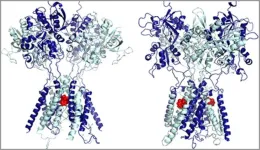(Press-News.org) LA JOLLA (November 14, 2024)—Excess cholesterol is known to form artery-clogging plaques that can lead to stroke, arterial disease, heart attack, and more, making it the focus of many heart health campaigns. Fortunately, this attention to cholesterol has prompted the development of cholesterol-lowering drugs called statins and lifestyle interventions like dietary and exercise regimens. But what if there’s more to the picture than just cholesterol?
New research from Salk Institute scientists describes how another class of lipids, called sphingolipids, contributes to arterial plaques and atherosclerotic cardiovascular disease (ASCVD). Using a longitudinal study of mice fed high-fat diets—with no additional cholesterol—the team tracked how these fats flow through the body and found the progression of ASCVD induced by high trans fats was fueled by the incorporation of trans fats into ceramides and other sphingolipids. Knowing that sphingolipids promote atherosclerotic plaque formation reveals another side of cardiovascular disease in addition to cholesterol.
The findings, published in Cell Metabolism on November 14, 2024, open an entirely new avenue of potential drug targets to address these diseases and adverse health events like stroke or heart attacks.
“Fat is a major component of our diet, and eating trans fats is known to drive heart disease. We used this phenomenon to understand the biological mechanisms putting us at risk,” says senior author Christian Metallo, professor and holder of the Daniel and Martina Lewis Chair at Salk. “There have been lots of studies investigating how trans fats drive cardiovascular risk, but it always comes back to cholesterol—we wanted to take another look that omits cholesterol as a factor, and we found an enzyme and pathway relevant to cardiovascular disease that we can potentially target therapeutically.”
When dietary fats enter the body through the foods we eat, they must be sorted and processed into compounds called lipids, such as triglycerides, phospholipids, cholesterol, or sphingolipids. Lipoproteins—like the familiar HDL, LDL, and VLDL—are used to transport these lipids through the blood.
Sphingolipids have become useful biomarkers for diseases like ASCVD, non-alcoholic fatty liver disease, obesity, diabetes, peripheral neuropathy, and neurodegeneration. However, it is unclear exactly how the incorporation of different dietary fats into sphingolipids leads to the development of ASCVD.
In particular, the researchers were curious to ask how the processing of trans fats into sphingolipids may be creating atherosclerotic plaques. They wondered, could sphingolipids created in the liver influence the secretion of lipoproteins like VLDL into the bloodstream that, in excess, cause arterial blockages?
The fate of dietary fat is often determined by the protein that metabolizes it, explains Metallo, so it was important for the Salk team to first explore the metabolic landscape that creates sphingolipids in the first place. They started their survey with a protein called SPT, which acts as a floodgate to regulate the synthesis of sphingolipids from fat molecules and amino acids (other cellular building blocks) like serine.
The team suspected that trans fats were being incorporated into sphingolipids by SPT, which, in turn, would promote the excess lipoprotein secretion into the bloodstream that causes ASCVD.
To test their theory, they compared the processing of two different fats, cis fats and trans fats. The difference between these two comes down to the placement of a hydrogen atom; cis fats, found in natural foods like fish or walnuts, have a kink in their structure caused by two side-by-side hydrogen atoms, whereas trans fats, found in processed foods like margarine or anything fried, have a straight-chain structure caused by two opposing hydrogen atoms. Importantly, the kink in cis fats means they cannot be tightly packed—a positive feature for avoiding impenetrable clogs.
The researchers combined mouse model dietary manipulation with metabolic tracing, pharmacological interventions, and physiological analyses to answer their question—what is the link between trans fats, sphingolipids, and ASCVD?
"We found the incorporation of trans fats through SPT increased lipoprotein secretion from the liver, which then promoted the formation of atherosclerotic plaques,” says first author Jivani Gengatharan, a postdoctoral researcher in Metallo’s lab. “This highlights sphingolipid metabolism as a key node in the progression of cardiovascular disease driven by specific dietary fats.”
Starting with cells in Petri dishes, the team looked at whether trans or cis fats were preferentially metabolized by SPT—and it turns out that SPT preferred trans fats. Furthermore, SPT’s bias for trans fats was causing downstream sphingolipid secretion that could go on to cause plaque formation.
Then, they moved from Petri dishes to mice, and Gengatharan designed otherwise identical diets containing either high trans or high cis fats but little cholesterol, feeding them to mice for 16 weeks. In the end, they saw mice consuming a high trans fat diet were producing trans fat-derived sphingolipids that promoted the secretion of VLDL from the liver into the bloodstream. This, in turn, accelerated the buildup of atherosclerotic plaques and the development of fatty livers and insulin dysregulation. High cis fat diet mice, on the other hand, experienced shorter-term, less harmful effects like weight gain.
To probe these effects further, they inhibited SPT to see whether they could limit negative trans fat effects in mice, finding that reducing SPT activity did decrease trans fat-induced atherosclerosis. According to Metallo, these findings make this sphingolipid synthesis pathway through SPT a critical target for ASCVD therapeutics moving forward.
“As we get a better grasp on identifying and measuring these diverse circulating molecules in our bodies and how they’re metabolized, we could make huge strides in personalizing medicine accordingly,” says Metallo. “For now, I recommend everything in moderation—we all have our own diets and genetics and predispositions. As we explore and understand those factors, we can improve our knowledge and expand treatment options in the future.”
One particular SPT subunit stood out to the researchers as the subject of future research, since the team suspects it is responsible for selectively spitting dangerous lipids out of the liver. With the spotlight on SPT, the team hopes to see new non-statin drug development plans for managing and preventing cardiovascular disease.
Despite the World Health Organization (WHO) announcing a plan to eliminate trans fats from food supplies by the end of 2023, nearly 4 billion people remain at risk in 2024 due to countries not abiding by WHO’s best practices. The team hopes their work can make a difference in the lives of individuals still at risk.
Other authors include Zoya Chih, Maureen Ruchhoeft, and Ethan Ashley of Salk; Michal Handzlik and Courtney Green of Salk and UC San Diego; Patrick Secrest and Philip Gordts of UC San Diego; and Martina Wallace of University College Dublin.
The work was supported by the National Institutes of Health (R01CA234245), Aileen S. Andrew Foundation, and Mary K. Chapman Foundation.
About the Salk Institute for Biological Studies:
Unlocking the secrets of life itself is the driving force behind the Salk Institute. Our team of world-class, award-winning scientists pushes the boundaries of knowledge in areas such as neuroscience, cancer research, aging, immunobiology, plant biology, computational biology, and more. Founded by Jonas Salk, developer of the first safe and effective polio vaccine, the Institute is an independent, nonprofit research organization and architectural landmark: small by choice, intimate by nature, and fearless in the face of any challenge. Learn more at www.salk.edu.
END
Cholesterol is not the only lipid involved in trans fat-driven cardiovascular disease
Salk scientists trace fat processing in mice, finding specific dietary fats are incorporated into sphingolipids to drive the development of atherosclerotic cardiovascular disease
2024-11-18
ELSE PRESS RELEASES FROM THIS DATE:
Study: How can low-dose ketamine, a ‘lifesaving’ drug for major depression, alleviate symptoms within hours? UB research reveals how
2024-11-18
BUFFALO, N.Y. — University at Buffalo neuroscientists have identified the binding site of low-dose ketamine, providing critical insight into how the medication, often described as a wonder drug, alleviates symptoms of major depression in as little as a few hours with effects lasting for several days.
Published in September in Molecular Psychiatry, the UB discovery will also help scientists identify how depression originates in the brain, and will stimulate research into using ketamine and ketamine-like drugs for other ...
New nasal vaccine shows promise in curbing whooping cough spread
2024-11-18
As whooping cough cases rise in the U.S., a new nasal vaccine developed by Tulane University may hold the key to reducing the spread of the highly contagious respiratory disease.
Current pertussis vaccines are widely used and effective at preventing whooping cough, caused by the Bordetella pertussis bacteria. However, the vaccines fail to clear bacteria from the upper respiratory tract, allowing even vaccinated individuals to spread the disease.
The new vaccine combines the traditional pertussis antigens with an innovative ...
Smarter blood tests from MSU researchers deliver faster diagnoses, improved outcomes
2024-11-18
Image
Highlights:
MSU researchers now can identify more proteins, or biomarkers, in blood plasma, including those linked to specific diseases like cancer.
By identifying these biomarkers earlier, medical researchers can create better diagnostic tests and drugs that target diseases sooner, improving patient outcomes.
EAST LANSING, Mich. – Medical professionals have long known that the earlier a disease is detected, the higher the chance for a better patient outcome. Now, a multidisciplinary team of Michigan State University researchers, in ...
Q&A: A new medical AI model can help spot systemic disease by looking at a range of image types
2024-11-18
Artificial intelligence is making impressive strides in its ability to read medical images. In a recent test in Britain's National Health Service, an AI tool looked at the mammograms of over 10,000 women and correctly identified which patients were found to have cancer. The AI also caught 11 cases doctors had missed. But systemic diseases, such as lupus and diabetes, present a greater challenge for these systems, since diagnosis often involves many kinds of medical images, from MRIs to CT scans.
Sheng Wang, a University ...
For low-risk pregnancies, planned home births just as safe as birth center births, study shows
2024-11-18
CORVALLIS, Ore. – In low-risk pregnancies, mothers and children are just as safe with a planned home birth as they are with a planned birth center birth, a national study led by Oregon State University researchers has shown.
The findings, published in Medical Care, contradict doctors’ long-held concerns about home birth, including a recent opinion by the American College of Gynecologists and Obstetricians that describes hospitals and accredited birth centers as the safest places to have a baby. A birth center is a health care facility designed to provide a more natural and home-like environment than a hospital.
OSU ...
Leaner large language models could enable efficient local use on phones and laptops
2024-11-18
Large language models (LLMs) are increasingly automating tasks like translation, text classification and customer service. But tapping into an LLM’s power typically requires users to send their requests to a centralized server — a process that’s expensive, energy-intensive and often slow.
Now, researchers have introduced a technique for compressing an LLM’s reams of data, which could increase privacy, save energy and lower costs.
The new algorithm, developed by engineers at Princeton and Stanford Engineering, works by trimming redundancies and reducing the precision of an LLM’s ...
‘Map of Life’ team wins $2 million prize for innovative rainforest tracking
2024-11-18
Traditionally, taking inventory of the species in a rainforest requires sending in a team of experts with field guides and binoculars for a multi-day expedition. But the devastating pace of the destruction of the world’s rainforests and increasing urgency to better monitor and protect what remains demand faster, easier, and more efficient approaches.
Several years ago, a Yale-based team devised an alternate approach: they use lightweight, unmanned aerial vehicles (UAVs) to collect this critical biodiversity data in remote areas.
Now they’ve collected ...
Rise in pancreatic cancer cases among young adults may be overdiagnosis
2024-11-18
Embargoed for release until 5:00 p.m. ET on Monday 18 November 2024
@Annalsofim
Below please find summaries of new articles that will be published in the next issue of Annals of Internal Medicine. The summaries are not intended to substitute for the full articles as a source of information. This information is under strict embargo and by taking it into possession, media representatives are committing to the terms of the embargo not only on their own behalf, but also on behalf of the organization they represent. ...
New study: Short-lived soda tax reinforces alternative presumptions on tax impacts on consumer behaviors
2024-11-18
Key Takeaway:
When policymakers enact consumption taxes to raise revenue for the government, consumers who oppose the tax may decrease their consumption more, leading to a reduction in tax revenue.
BALTIMORE, MD, November 18, 2024 – One of the most common assumptions tax policymakers make is that by raising taxes, they will raise revenue for the government. However, a new study that centers on a soda tax in Washington state has reinforced alternative presumptions about tax impacts on consumer behaviors.
Researchers found that when Washington state enacted a tax on soda, it not only generated backlash in the consumer marketplace and political ...
Fewer than 1 in 5 know the 988 suicide lifeline
2024-11-18
PHILADELPHIA – Annenberg Public Policy Center survey data show that public recall of the 988 Suicide & Crisis Lifeline number has grown slowly since the three-digit phone number was introduced in July 2022. Just 15% of U.S. adults are familiar with it, as of September 2024.
Survey respondents who accurately report awareness of the Suicide & Crisis Lifeline number increased significantly from August 2023 (11%) to September 2024 (15%). Those 15% of respondents reported both that they knew the number and, when asked in an open-ended format, said the number ...
LAST 30 PRESS RELEASES:
Numbers in our sights affect how we perceive space
SIMJ announces global collaborative book project in commemoration of its 75th anniversary
Air pollution exposure and birth weight
Obstructive sleep apnea risk and mental health conditions among older adults
How talking slows eye movements behind the wheel
The Ceramic Society of Japan’s Oxoate Ceramics Research Association launches new international book project
Heart-brain connection: international study reveals the role of the vagus nerve in keeping the heart young
Researchers identify Rb1 as a predictive biomarker for a new therapeutic strategy in some breast cancers
Survey reveals ethical gaps slowing AI adoption in pediatric surgery
Stimulant ADHD medications work differently than thought
AI overestimates how smart people are, according to HSE economists
HSE researchers create genome-wide map of quadruplexes
Scientists boost cell "powerhouses" to burn more calories
Automatic label checking: The missing step in making reliable medical AI
Low daily alcohol intake linked to 50% heightened mouth cancer risk in India
American Meteorological Society announces Rick Spinrad as 2026 President-Elect
Biomass-based carbon capture spotlighted in newly released global climate webinar recording
Illuminating invisible nano pollutants: advanced bioimaging tracks the full journey of emerging nanoscale contaminants in living systems
How does age affect recovery from spinal cord injury?
Novel AI tool offers prognosis for patients with head and neck cancer
Fathers’ microplastic exposure tied to their children’s metabolic problems
Research validates laboratory model for studying high-grade serous ovarian cancer
SIR 2026 delivers transformative breakthroughs in minimally invasive medicine to improve patient care
Stem Cell Reports most downloaded papers of 2025 highlight the breadth and impact of stem cell research
Oxford-led study estimates NHS spends around 3% of its primary and secondary care budget on the health impacts of heat and cold in England
A researcher’s long quest leads to a smart composite breakthrough
Urban wild bees act as “microbial sensors” of city health.
New study finds where you live affects recovery after a hip fracture
Forecasting the impact of fully automated vehicle adoption on US road traffic injuries
Alcohol-related hospitalizations from 2016 to 2022
[Press-News.org] Cholesterol is not the only lipid involved in trans fat-driven cardiovascular diseaseSalk scientists trace fat processing in mice, finding specific dietary fats are incorporated into sphingolipids to drive the development of atherosclerotic cardiovascular disease





